Worth Cracking a Coconut: Murghi Hara Masala (From 660 Curries)
This recipe comes from Raghavan Iyer’s sister’s neighbor in Mumbai, and it is a fabulous combination of flavors and aromas. Imagine fresh mint and cilantro, fresh coconut, yogurt and garam masala cooked into a thick yellow-hued curry with sauce that clings to the strips of chicken breast. I did add some whole spices to the cooking oil–cardamom and cinnamon–because I love the way they scent the air when I am cooking.
Iyer says that you can substitute dehydrated (unsweetened) coconut flakes for the fresh coconut, but I thought that this recipe sounded so scrummy that I just had to buy a fresh coconut and take a crack at cracking it, prying the meat from the shell, and grating it.
I have to admit that most of the work of this recipe revolved around the coconut. And let me say right now that just because I was stubborn and went through the time, trouble and effort to play with the fresh coconut doesn’t mean you have to. You can take Iyer’s advice and use dehydrated coconut that has been soaked in water, instead of the freshly grated coconut meat.
Now you are going to want to know how to go about cracking open a coconut. As you can see from the photograph, the process is somewhat violent in nature and definitely messy. Be prepared to get down and dirty with this process. Or, if not dirty, at least, a bit sticky and disheveled.
Also the sound that a coconut shell makes as it cracks is a little bit disturbing if you have a good imagination and have been reading about ancient weapons like war hammers and morning stars. I highly suggest not mixing the reading of the bloodier parts of European history with the work of cracking a coconut. You can do one, or the other, but probably not both.
At least, not without a moment to pause, reflect, and perhaps become a little queasy, especially if you are the squeamish sort.
A lot of folks use a hammer and nail to open a coconut by pounding the nail into the three “eyes” or black indentations on one end of the coconut and whapping at it with the hammer until it cracks. Then, the hard shell can be pried apart by using a screwdriver as a lever or chisel, with the ever present hammer as a means of thwapping, whapping and violent disresembling.
I didn’t do it that way. I couldn’t find a good nail, so I used my nail puller, which has a pointy, beak-like chiselish end made of steel that can stand up the force of a nice big hammer. It is also bigger than a nail, so I figured it would make a nice big crack in the shell. And it did–eventually. Not before I made a lot of a mess and noise, but the coconut eventually succumbed to my superior force and will, and fell apart. After the coconut was pried apart in pieces, then I used a table knife and a bit of swearing and sweating to prise the white meat from the hairy shell, and then–and then–I could finally cut the meat into bits and put it into the Sumeet to be ground finely.
It was a procedure that I would rather not repeat any time in the near future, but I have to say it made a damned fine curry.
One thing about this recipe–in the book the ingredients list looks short, but that is because Iyer refers the cook back to a recipe for hara masala–a blend of cilantro, mint, garlic and ginger. It isn’t a hard recipe–here is how it goes: 1 cup firmly packed fresh cilantro leaves and stems, 1 cup firmly packed mint leaves, 8 medium sized garlic cloves and 1 1/2′ cube fresh ginger, peeled and cut into thin slices. Basically, you just chop this stuff up in a food processor until it makes a brilliant emerald colored, extremely fragrant paste. The chicken curry only requires 1/2 cup of this paste, so you can freeze the rest in an airtight freezer bag to be used later in another recipe.
In this recipe, the hara masala is mixed into well-beaten yogurt and is used as a marinade and also as the basis of the sauce. My one criticism of this curry is the color of the sauce can be a bit odd–the brilliant green yogurt marinade is eventually cooked with tomatoes and turmeric, which results in an odd somewhat greenish-brownish yellow shade that is a little weird. I found that adding just a bit more turmeric helps bring the color of the curry around to a prettier hue.
Really if the worst I can say about this delicious, fragrant curry of tender chicken in a thick, clingy sauce that is what the British would call “very moreish” , is that it has a somewhat funny color–well–then I guess it is pretty exemplary. It is the second recipe I have tried almost completely unaltered, from the book, 600 Curries, and I found that as much as I loved the lamb, I loved the Murghi Hara Masala even more.
I hope that some of you give this recipe a try and let me know what you think of it. And, again, if I were you, I’d take the alternative route and use the dehydrated unsweetened coconut flakes instead of wrestling a fresh coconut all over your kitchen, especially if you have not dealt with one before. The next time I make this curry–and there will be a next time–I will try the dehydrated coconut and see if it makes a curry as tasty as the fresh did.
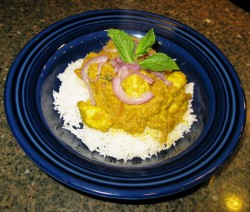
Murghi Hara Masala
Ingredients:
1/2 cup hara masala–see body of the post above for recipe
1/4 cup plain yogurt whisked until smooth
1 1/2 teaspoons coarse kosher or sea salt
2 pounds boneless skinless chicken breasts, trimmed and cut into slices about 3/4″ wide
4 tablespoons canola oil or ghee
1 large red onion, thinly sliced
1 large tomato, peeled, seeded and chopped–I substituted 6 ounces of home-canned tomatoes here
2 teaspoons garam masala–I used my own house blend here that includes cinnamon, cloves, nutmeg, mace, cumin, coriander and a bit of fennel seed–or you could use Penzey’s Punjabi garam masala, or your own mixture or another pre made brand.
1/4 teaspoon ground turmeric–I ended up using half again as much to help make the color of the curry prettier
1/2 cup shredded fresh coconut or 1/4 cup dried unsweetened coconut flakes, rehydrated with 1/4 cup of boiling water–let it sit for fifteen minutes and drain.
Method:
Mix the hara masala, the yogurt and the salt together and whisk until it all is thoroughly combined into a lovely pale jade cream. Add the chicken strips to the marinade, and stir them up to make sure to coat every bit of chicken meat with the yogurt mixture. Cover and put in the fridge for at least 30 minutes, but no longer than an hour or two.
Heat two tablespoons of the oil in a large, heavy bottomed skillet and add half the onion, and cook until the slices wilt and turn a rich brown around the edges. Add the tomato, the garam masala and turmeric. (When you cook the onion, you can add a 1″ stick of cinnamon and about four cardamom pods to scent the oil beautifully.)
Cook, stirring now and again until the tomato releases some of its liquid and softens up–about five minutes.
Add the chicken and all of the marinade, scraping it out of the bowl if necessary. You don’t want to waste one little bit of this stuff, trust me. Cook, stirring as needed to keep the chicken from sticking until the chicken is very nearly cooked through–about seven minutes.
While the chicken simmers, heat another, small skillet over medium heat and add the remaining oil. Add the second half of the onion and cook, stirring until it wilts and turns golden brown on the edges. Add the shredded coconut and keep stirring until it has lightly browned–this should take between two and three minutes. add 1/2 cup of water and scrape the skillet to deglaze it, scraping up every little bit of browned onion and coconut you can. Transfer this mixture to a blender and puree into a pinkish paste, then add to the chicken. Give it a stir or two, let it simmer for the remaining minute or so it will take to finish cooking the chicken and serve with steamed basmati rice and a great selection of vegetable dishes.
This recipe makes enough for about six hungry adults, especially if you have lots of side dishes.
9 Comments
RSS feed for comments on this post.
Sorry, the comment form is closed at this time.
Powered by WordPress. Graphics by Zak Kramer.
Design update by Daniel Trout.
Entries and comments feeds.

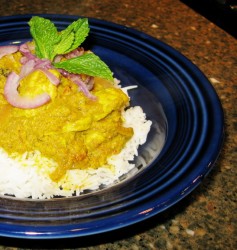
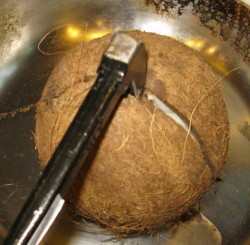
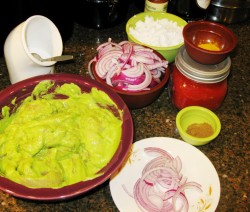
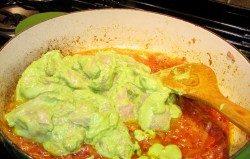


hi barbara,
nice to read about the cracking of a coconut. it must have been really a herculean task for you !
for myself, even though living in a coconut-covered culture, i don’t know still to open a coconut ! don’t be surprised, as in my home, it is usually the men’s job. we use a special, large knife (actually, its not a knife, but a larger weapon, in fact!) called a ‘vettukathi.’ my father is an expert in getting two perfect portions at one go. at many rituals also, cutting open the coconut is mandatory, like onam.
as for scrapping, we have these traditional scrappers called ‘chirava,’ which is a must in every home. it is a sharp blade fixed on a wooden seat. the structure is so that you can scrap the coconut sitting on the wooden seat. these days, table-mounted scrappers are also available. i’d love to have one, but need a larger counter top for that.
Comment by renu — June 10, 2008 #
I am dying to get this book–that looks wonderful.
I did want to pop in and say that some Indian grocers sell frozen shredded fresh coconut, so that might be a good option if you can find it.
Comment by Laura — June 10, 2008 #
hi barbara
I open the coconut by smacking it to a rock or concrete floor!![outside house ofcourse!],hold a towel or thick cloth over the coconut and smack it hard,it will crack open.
frozen grated coconut also works very fine[a little costly] the brand daily delight is good.
Comment by smitha — June 10, 2008 #
Hi Barbara,
I read your blog regularly, but this is my first time commenting. Back home we crack coconut daily. This is how we do it. Out of the three “eyes” find the one soft eye. Hold the coconut firmly in your left hand and hit the coconut on the edge across from the soft eye (so that you hit the coconut exactly in the middle from the eyes and the other pole). I use a hammer for this. Coconut will break exactly in two. I can break a coconut in one try now, but you might need to hit a few time until you are used to it. To scrap coconut we use a coconut scraper (available in indian/asian stores now). Hope this helps. It is only recently that I found a place to buy good fresh coconut. You are lucky to be able to get good fresh coconut. Also I prefer frozen coconut to dehydrated ones.
Nice recipe. I plan to try it. Similar to the way I make white (oyster or lion’s mane) mushrooms.
Comment by anonymous — June 10, 2008 #
Frozen coconut is readily available in Asian markets, and it’s mostly what I use for recipes needing fresh coconut.
However, when I do want to scrape a coconut I crack it simply by hitting it a few times at the “equator” line with the back (dull) side of a cleaver. A few knocks and it opens up in half nicely. You can tell it’s getting about ready to crack when the sound changes to a slightly dull “thwack” from a clear bell like “ping.” Then I grate it using the chair/scraper thing that renu mentioned above.
Comment by Diane — June 10, 2008 #
This website has a pictorial about the coconut grater (scraper) commonly used in India and Sri Lanka:
http://www.wildernessfamilynaturals.com/coconut_grater.htm
Comment by dw — June 11, 2008 #
Sounds like a fun excuse to bash and hammer and twack something if you’re in that kind of mood!
“Oh no, I’m not violent. I’m just making curry!”
Comment by Neohippie — June 11, 2008 #
Hm – Wiki How has a lot of good tips – including some on how to get the meat out faster of an already cracked coconut if you don’t want to scrape:
http://www.wikihow.com/Cut-Open-a-Coconut
Comment by Bastlynn — June 11, 2008 #
Barbara:
I have enjoyed reading your site for months now. Tonight (06/14/08) was the first time I tried one of your recipes. This was also my first time making a curry. In the past, other curry recipes’ ingredient lists were too intimidating. This one looked more do-able. As a culinary grad and former restaurant cook, it had been a long time since I had been this excited to make a dish. It turned out very good and all your hints were helpful. The textures/colors of mine didn’t quite match yours, but flavor counts most and it was delicious. I have printed many of your recipes and look forward to trying more. Not to mention, I now MUST OWN “660 Curries” and “Indian Spice Kitchen”.
Thanks for the inspiration!
~Lisa
Comment by Lisa — June 14, 2008 #